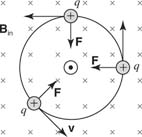This magnetic attraction or repulsion can be explained as the effect of one magnet on the other, or it can be said that one magnet sets up a magnetic field in the region around it that affects the other magnet. The magnetic field at any point is a vector. The direction of the magnetic field ( B) at a specified point is the direction that the north end of a compass needle points at that position. Magnetic field lines, analogous to electric field lines, describe the force on magnetic particles placed within the field. Iron filings will align to indicate the patterns of magnetic field lines.
Force on a moving charge
If a charge moves through a magnetic field at an angle, it will experience a force. The equation is given by F = q v × B or F = qvB sin θ, where q is the charge, B is the magnetic field, v is the velocity, and θ is the angle between the directions of the magnetic field and the velocity; thus, using the definition of the cross product, the definition for the magnetic field is

Magnetic field is expressed in SI units as a tesla (T), which is also called a weber per square meter:

The direction of F is found from the right‐hand rule, shown in Figure 1.
| Figure 1 |
Using the right-hand rule to find the direction of magnetic force on a moving charge.
|
|
To find the direction of the force on the charge, with a flat hand point your thumb in the direction of the velocity of the positive charge and your fingers in the direction of the magnetic field. The direction of the force is out of the palm of your hand. (If the moving charge is negative, point your thumb opposite to its direction of motion.) Mathematically, this force is the cross product of the velocity vector and the magnetic field vector.
If the velocity of the charged particle is perpendicular to the uniform magnetic field, the force will always be directed toward the center of a circle of radius r, as shown in Figure 2. The x symbolizes a magnetic field into the plane of the paper—the tail of the arrow. (A dot symbolizes a vector out of the plane of the paper—the tip of the arrow.)

| Figure 2 |
The force on a charge moving perpendicular to a magnetic field is toward the center of a circle.
|
|
The magnetic force provides centripetal acceleration:

or

The radius of the path is proportional to the mass of the charge. This equation underlies the operation of a mass spectrometer, which can separate equally ionized atoms of slightly different masses. The singly ionized atoms are given equal velocities, and because their charges are the same and they travel through the same B, they will travel in slightly different paths and can then be separated.
Force on a current-carrying conductor
Charges confined to wires can also experience a force in a magnetic field. A current (I) in a magnetic field ( B) experiences a force ( F) given by the equation F = I l × B or F = IlB sin θ, where l is the length of the wire, represented by a vector pointing in the direction of the current. The direction of the force may be found by a right‐hand rule similar to the one shown in Figure . In this case, point your thumb in the direction of the current—the direction of motion of positive charges. The current will experience no force if it is parallel to the magnetic field.
Torque on a current loop
A loop of current in a magnetic field can experience a torque if it is free to turn. Figure (a) depicts a square loop of wire in a magnetic field directed to the right. Imagine in Figure (b) that the axis of the wire is turned to an angle (θ) with the magnetic field and that the view is looking down on the top of the loop. The x in a circle depicts the current traveling into the page away from the viewer, and the dot in a circle depicts the current out of the page toward the viewer.
Figure 3